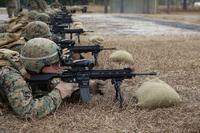After years of warnings that major cuts to Army family programs are coming, officials with the Army's Installation Management Command announced that the day has finally arrived.
"The bottom line is in fiscal year '17, beginning in October, we're going to have a little less money to put into our family Morale, Welfare and Recreation programs than we have in previous years," Lt. Gen. Kenneth Dahl, head of Army Installation Management Command (IMCOM), which oversees family programs, said in a video posted on the command's YouTube channel Aug. 30.
Until now, command officials said, Army budget shortfalls have been covered through non-appropriated fund accounts, which are filled by sales and exchange dividends. But that model isn't sustainable long term, and anything that isn't covered by taxpayer dollars must now be cut. Last year saw a $105 million overage.
"I can't afford to keep borrowing money from our IMCOM bank accounts in order to reprogram into these funds," Dahl said.
Rather than direct which programs to cut, Dahl has told garrison commanders the programs they must keep -- and is leaving the rest up to them. Child care centers and child and youth services programs are safe from cuts, he said in the video, but almost everything else is fair game.
To help commanders decide what to cut, the command has sent out a program priorities list known as the "bin chart," officials said.
The chart, which was presented at the 2015 Association of the United States Army conference family forums and obtained by Military.com, lists programs in order of importance. "High priority" programs, such as school support services, are considered safe from cuts. "Moderate" and "low priority" programs, such as arts and crafts programs and spouse employment readiness services, are not.
"My point there is that I'm not going to make those decisions here at the IMCOM headquarters," Dahl said. "What we're allowing is you garrison commanders and senior commanders at the local level to determine how they can absorb this reduction in funding."
Programs at rural posts, such as Fort Greely, Alaska, and Fort Irwin, California, will be spared from the cut sheet because they are not available outside the gate, he said.
"They are remote and isolated; there are no alternatives off the installation," Dahl said. "So we're not looking at scaling back any of the services that we provide there."
Instead of completely closing programs, Dahl said that users are more likely to see a reduction in hours or fewer types of services offered at certain locations.
For example, command officials said, a skeet range at Fort Huachuca, Arizona, is no longer selling guns but is otherwise staying in operation. Officials at Fort Huachuca also announced on the post's Facebook page that they are planning to make changes to its Arts and Crafts Center so that it can become self-supporting.
Dahl said he is asking commanders to use their knowledge about their own communities to guide which programs to reduce or eliminate.
"Which programs are most important? Which programs are least important? How can they mitigate it? Do they want to go with flexible hours? Do they want to integrate volunteers? Do they want to sustain these programs that are most important to the community by closing once a day or perhaps charging a fee or an additional fee," he said.
But Army family program advocates worry that it's exactly that freedom that will result in Army families losing programs they've traditionally known they can rely on at every installation.
"When I think about consistency, I'm hoping that there are core programs that are always going to be there," said Patty Barron, who directs the Association of the United States Army's family programs, as well as its annual family forum with top Army leaders.
Barron said that she has heard through AUSA forums at individual bases that garrison officials often rely on unit commanders to communicate what programs families use and enjoy, but that those commanders don't always conduct thorough research before giving their feedback.
And that lack of communication, she said, could result in cuts.
Still, Dahl's video announcement is the first time in recent memory that upcoming, across-the-board Army family program cuts have actually been put into action and that a senior leader has made an effort to communicate them.
"We were very appreciative that he did come out with that video and he was very open about what was happening," she said. "We hope that openness can continue."
-- Amy Bushatz can be reached at amy.bushatz@military.com.




























